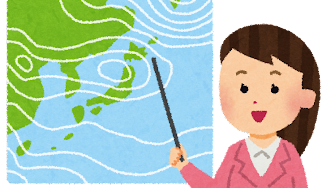When preparing your suitcase for a well-deserved holiday, we all are faced with these questions:
“But what should I wear?” and
“How can I know how the weather is there?”
The climate in the Okinawa islands is a subtropical climate, and the presence of the sea everywhere added to it creates a very changeable weather. Often, temperatures drop or pike with quite a few degrees of difference from one day to another. What set of clothes would be the most sensible and practical?
Read our guide and you’ll know all about the Okinawan climate, what kind of clothes is a must here, and the most useful online tools that locals use to go on with their lives. Everything you need to plan your trip here is below!
▼ Summary▼
1・Features of the Okinawan climate
2・What to wear? Monthly recommendations.
3・Live broadcast for the latest weather reports
4・Get the latest updates on the sea conditions!
Features of the Okinawan climate
● Average air and sea temperatures in Okinawa
In Okinawan, the air temperatures rarely go below 10°C in winter while they not often go beyond 35°C in summer. Those numbers do not vary very much throughout the year, and the fours seasons are not as distinct as they are in mainland Japan. You could say that in Okinwa, we enjoy a long summer and a short winter.
● Okinawan rainy season : May and June
The rainy season usually starts in May and ends in late June. Its end is the official start of the long, sunny summer days. Although it can starts raining quite suddenly anywhere in Okinawa, it will most likely drizzle. Stronger rains usually do not last for more than a day. You are more susceptible to encounter sudden showers that stop as abruptly as they started than continuous heavy rains. If you see a lot of people here without umbrellas, it is simply because “Okinawan people do not keep umbrellas ready in their homes”!
● Okinawan typhoons season : July to September
After the rainy season comes the season of typhoons: Okinawa is one of the main areas in Japan that is often crossed by typhoons. Usually, typhoons emerge around May and more or less make their way north to Okinawa by October.Miyako or the Yaeyama Islands are more vulnerable to typhoons than the main island of Okinawa. Most typhoons do not hit the main island directly and pass by it on their way North. However, typhoons will affect the sea conditions regardless, causing most shops to cancel their water sports activities or sailing trips to the outlying islands. Remember to pay close attention to the sea/typhoon condition if you’re plan visiting Okinawa during the typhoon season.
● UV rates in Okinwa: the highest in Japan!
The Okinawan sun is not only very hot, but its rays are also strong throughout the year. When you stay directly under the sunrays, it will soon start to feel very hot. So no matter which season you choose to visit here, make sure that you are using plenty of sunscreen.
● The Okinawan monsoon: the northeast cold currents prevail
From December to March, the northeast winds get powerful and can remind you very strongly of a typhoon. As there are no high mountains around the main island of Okinawa to block them, a windproof jacket is a must when going outside. If you go on an activity at sea in autumn or winter such as diving or whale-watching trips, remember to pay close attention to the sea conditions!
● Get the latest updates on the Okinawan weather!
Okinawa is surrounded by the sea and its weather is very unpredictable! The weather forecast is often used as a mere reference here. Rain may be announced but not the drop will be seen, and moe than once, it will rain not matter if it was predicted or not. We recommend you to always check again before any departure or outings.
What to wear ? Monthly recommendations
| Spring |  |  |  |
 |  |  | |
| Attire of choice | While it’s fairly warm during the day, you’ll still need long-sleeved clothing at night | The most pleasant season! You can get by wearing thin sleeved tops or short-sleeved T-shirts, jeans, etc. | The weather is often muggy. Perfect for short-sleeved shorts |
| Average temperatures | Max. 25.5 ℃ Min. 11.4 ℃ Average 19.0 ℃ | Max.28.8℃ Min. 16.7℃ Average 22.2℃ | Max.30.5 ℃ Min. 18.8 ℃ Average 24.9 ℃ |
| Average water temperatures | 21.4 ℃ | 22.8℃ | 23.5 ℃ |
| Summer |  |  |  |
 |  |  | |
| Attire of choice | Be sure to use sunscreen and sunglasses. Wear something light. | Wear something light and put on sunglasses to protect you from the sun. | Hats and sunglasses recommended! Prepare long-sleeved shirts to protect you from the sun. |
| Average temperatures | Max. 32.5 ℃ Min. 24.4 ℃ Average 28.7 ℃ | Max. 33.8 ℃ Min. 23.8 ℃ Average 29.0 ℃ | Max. 32.8 ℃ Min. 24.9 ℃ Average 28.7 ℃ |
| Average water temperatures | 26.6 ℃ | 28.5 ℃ | 29.2 ℃ |
| Autumn |  |  |  |
 |  |  | |
| Attire of choice | The heat is fading but you can still swim at the beach. Always wear sunglasses! | Short sleeves during the day and light long-sleeved clothing in the evening or early morning will be best. | We recommend you to bring thin, long-sleeved clothing and items such as cardigans. |
| Average temperatures | Max. 32.6 ℃ Min. 23.8 ℃ Average 27.8 ℃ | Max. 32.0 ℃ Min. 20.0 ℃ Average 25.5 ℃ | Max. 29.8 ℃ Min. 16.6 ℃ Average 23.8 ℃ |
| Average water temperatures | 27.8 ℃ | 27.0 ℃ | 25.5 ℃ |
| Winter |  |  |  |
 |  |  | |
| Attire of choice | A warm winter. Sweatshirts and jeans, etc will be perfect. | Strong winds. The real feel will often be cooler than the actual temperatures. It’s best to have a jacket. | Strong winds. The real feel will often be cooler than the actual temperatures. It’s best to have a jacket. |
| Average temperatures | Max. 26.9 ℃ Min. 14.0 ℃ Average 20.1 ℃ | Max. 23.5 ℃ Min. 9.8 ℃ Average 16.6 ℃ | Max. 25.0 ℃ Min. 9.6 ℃ Average 16.8 ℃ |
| Average water temperatures | 23.8 ℃ | 21.3 ℃ | 20.7 ℃ |
Updates on the Okinawan weather
Receive the latest updates on the Okinawan weather conditions with the Naha Airport weather live.
Updates on the sea conditions
With Windy, you can get information of the waves, the wind direction and overall weather for up to the next 10 days.
If you have planned any water sports trips, you should start paying attention to the sea conditions counting 3 days before it. That is especially true during typhoon season between July and September, as well as between December and March where you have gusts of wind coming from the North.
*Click the wave icon on the upper right to check the wind, temperature, water temperature, etc.

Here’s for our information on the Okinawan weather! I hope that everyone can now prepare their trip with confidence and in fun.

